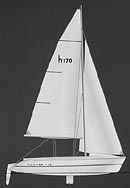Hunter 170
Family Daysailerr
We'll start this month with a new 16 foot, 10 inch daysailer from Hunter Marine. We have seen sensible daysailers make something of a comeback in the last five years, with a new breed that is high on comfort and stability, while sacrificing blistering planing speeds. If you live in a colder area like Seattle, with its 49-degree year-round water temperature, you will certainly appreciate a small boat you can sail without getting wet.
This is a contemporary-looking boat in keeping with the current Hunter line. I don't think it's particularly good looking. The sheer is flat and the Hunter hull-to-deck joint with its rubber "rubbing cap" makes for a definite Clorox-bottle appearance. Still it's not bad looking either, and functionally, this boat is very well thought out. Four adults could sail it very comfortably. I'm sure you could sail with six if that's your inclination.
Designed by the Hunter factory design team, this boat is beamy and deep enough to allow the entire centerboard to be housed below the cockpit sole. This has the advantage of giving you a wide open cockpit. There is a raised, molded-in foot rest running down the centerline of the cockpit. The transom is open, allowing easy access to the kick-up rudder and the kick-down 2.5-horsepower electric motor. We could get into a lengthy discussion of auxiliary power on daysailers, but suffice it to say that there are many beginning sailors who will welcome a "no-brainer" way of getting home. I personally would not give up the fun and challenge of handling a small boat around the docks under sail; sailing in and out of mooring situations can be valuable sailhandling training.
The open transom appeals to me because I need an easy way to haul my 55-pound dog aboard. If I leave the beach without her she'll just swim after me whimpering and snorting up salt water until I heave-to and help her up. I even had a dog cockpit installed in my sea kayak. The rig is a simple, fractional sloop with swept spreaders. There is no mainsheet traveler and the sheeting is midboom. This is very convenient for the skipper with the tiller in one hand and the mainsheet in the other. It also cleans up the stern of the boat, making access to the open transom easier.
There is a short, about 14-inch, optional stainless tube bowsprit frame on the boat in the photos, part of an asymmetrical chute package. The jib is roller furling, and the mainsail loose footed. Assuming that crew weight is "ballast" and adding four 175-pound crewmembers to the 480-pound boat weight, I come up with an SA/D of 21.49.
There is a nifty covered bow area for gear. With the cover off, this spot would be perfect for a small child or a dog. My dog always wants to drive.
If you have been reading sailing books and magazines for a while and just waiting for the right boat to get you and your family out under sail, now's the time. Try a Hunter 170. You'll love it and you'll be able to say salty things like, "helm's a lee."

Comments